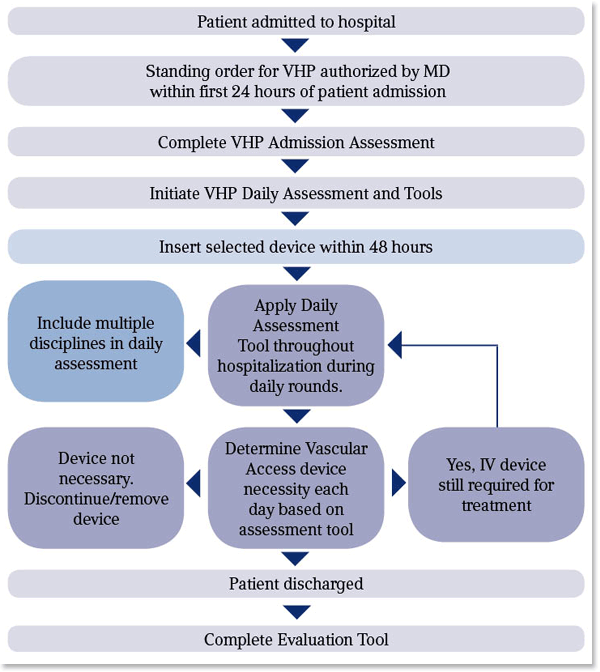VESSEL HEALTH AND PRESERVATION™
Insertion of an intravascular access catheter is the most common invasive procedure performed with hospitalized patients. Selecting the right line for the right patient at the right time is vital to providing reliable vascular access as well as preserving the vasculature of the patient for future access needs. Timely, intentional proactive intervention for device selection within 24 hours and placement within 48 hours of admission into any acute facility provides for consistent access, reduced delays and improved patient satisfaction.
Until recently, little had been done to establish an intentional process for vascular access selection and management for this common invasive procedure. Traditional intravenous access was reactive, painful and ineffective. It often resulted in exhaustion of all peripheral veins prior to consideration of other access options. Clinical pathway models improve outcomes by reducing variations and establishing processes to evaluate and coordinate selection and placement of a vascular access device.
 A new vascular access pathway approach is now available based on evidence, standards and best practice guidelines called the Vessel Health and Preservation Protocol (VHP) (). The protocol uses clinical pathways to improve vascular access device selection and site selection while reducing risk and focusing on patient safety. Developing an organized approach to vascular access provides the educational, regulatory and clinical outcomes necessary for reliable vascular access and improved patient safety.
A new vascular access pathway approach is now available based on evidence, standards and best practice guidelines called the Vessel Health and Preservation Protocol (VHP) (). The protocol uses clinical pathways to improve vascular access device selection and site selection while reducing risk and focusing on patient safety. Developing an organized approach to vascular access provides the educational, regulatory and clinical outcomes necessary for reliable vascular access and improved patient safety.
According to the CDC, a central venous access vascular access device is any device with a lumen used for infusion or hemodynamic monitoring of any kind with the terminal tip residing in a great vessel. Selection of the right device to deliver prescribed medications in a timely manner is paramount to patient safety and recovery. Reducing risk and unnecessary harm in the hospital environment begins with assessment of the patient's condition, history and relative vessel health.